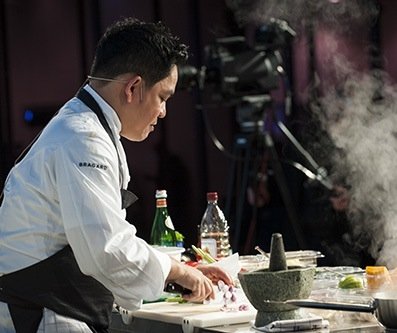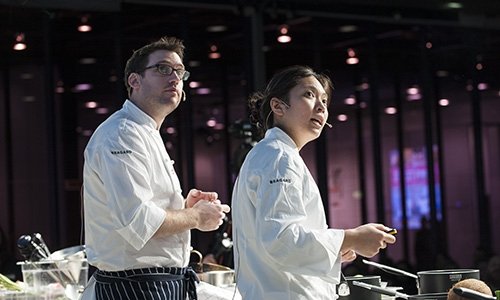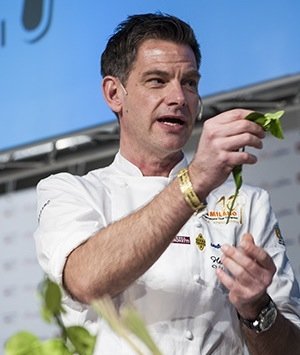The third day of the congress sees Thailand as the guest nation in the Auditorium hall. This is an excellent chance for a closer look on one of the most refined and interesting Asian cuisines. Very popular all around the world, with around 15,000 restaurants across 5 continents, it turns out it is much richer in facets than one might think at first glance. Born from the fusion of Chinese and Indian cuisine, and very complex in its regional variants – just like Italian cuisine – it is enriched with the aromas of herbs and spices and with the contrasts between the sweetness of coconut milk, the sapidity of the fish sauces and the spiciness of chilli. During the day, other points of contact between Italian and Thai cuisine emerge, for instance in the use of pork lard or of some vegetables and herbs. The greatest interpreters of Thai cuisine, both at home and abroad, alternate themselves on the stage, presenting recipes with a very close link to this ancient and vast tradition, sometimes re-interpreted or contaminated, but never abandoned.

Chumpol Jangprai, tireless ambassador of the best Thai flavours overseas
After all, the leading “technology” on the worktable is a stone mortar: each chef has his own. The first to get on stage is
Chumpol Jangprai, a true ambassador of Thai cuisine at home and abroad, the executive chef of the
Blue Elephant gastronomic empire and a television celebrity chef.
Jangprai presents three recipes that are inspired by Thai tradition but are contaminated with a touch of Italy and with a modern approach to presentation: the prawn cakes – in which river prawns are substituted by sea prawns – create a symphony of hot and spicy notes (garlic, coriander root, pepper) where the crispiness of the rice flakes breading is in contrast with the soft texture of the prawns crushed with lard and egg white. The scented jasmine rice is seasoned with chicken stock, lemongrass and saffron and then creamed in a thick coconut milk.
Gang Lian is a curry made with pumpkin, mushrooms, herbs and chicken to be paired with the pan-fried sea bass fillets.

Dylan Jones and Bo Songvisava of restaurant Bo.lan in Bangkok, sustainability with a Slow Food sauce
, Austrialian
David Thompson’s sous chef at
Nahm in Bangkok, instead, presents two dishes from Northern Thailand, from the province of Chiang Mai – to be more accurate. The cuisine at
Nahm is based on home recipes passed on in the families or found in ancient books, respectful of tradition even when it comes to the order of service, according to which, soups need to be served necessarily at the end. In his vegetarian curry based on vegetables, herbs and spices crushed in the mortar (garlic, galangal, shallot, lemongrass and the super-hot Thai Dragon chilli), the sweetness and sapidity come from the ingredients themselves without any addition of salt or sugar. The second recipe – inherited from his mother, originally from Burma – is almost a tribute to Italian
ragù, a tasty relish made with the fat parts of pork and with tomatoes (originally, the small, acid and white ones from Northern Thailand, in this case replaced with the Italian ones bought this morning by the chef, from the market) and a secret ingredient: a fermented bean paste, typical of his area.

Danish Henrik Yde with a wide plethora of Thai and Asian restaurants in Copenhagen, including Kiin Kiin, one Michelin star
– patron-chef at
Kiin Kiin, a fine-dining restaurant in Copenhagen and Bangkok, as well as of many other restaurants in Denmark, with a more casual format – presents a contemporary version of Thai cuisine in which the original recipes and most of all the basic preparations, are entirely home made and associated with techniques from French cuisine and modern presentations. The focus of
Yde’s lecture is again the search for umami, whether it may come from fermented cabbage in the Thai version of kimchi or from the oyster sauce that is to be paired with braised beef and dark spices.
The multi-ethnic couple formed by
Dylan Jones and Bo Songvisava – who met in Nahm’s kitchens in London and now run
Bo.lan restaurant in Bangkok – bring a wave of “homely” fun and an interesting interpretation of Thai cuisine based on the recovery of ancient recipes and the rediscovery of local ingredients and products, faithfully following the
SlowFood philosophy which is so essential, both to their cuisine and to the future of the planet. While taking jokes and teasing each other, Bo and Dylan present a hot black olive and chilli relish and give a demonstration of the “art of the mortar” by preparing the paste for a green curry in the original Thai version: without lime and coriander leaves, contrary to how many people prepare it.